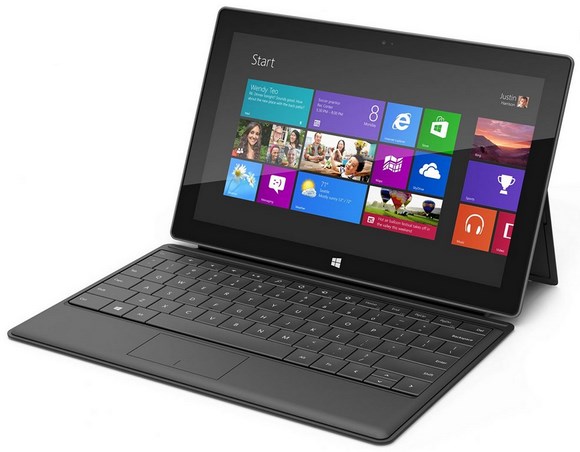Microsoft Surface with Windows RT Review
Surface With Windows RT Design
We’re not going to sensationalize Surface and call it Microsoft’s bold entry into the hardware business like some others have, because quite frankly Microsoft has been making nice hardware for many years. At one point or another, Microsoft has made some of the best game controllers available, they’ve been offering a wide range of input devices nearly since the dawn of the GUI, and let’s not forget about the Xbox and Xbox 360 consoles, which are essentially full computers in their own right that have custom processors, GPUs, memory, storage, etc. Versions of Windows have even been available for ARM-based embedded devices, PDAs, and smartphones in the past as well, but they were based on a difference kernel and obviously not in the same class as Windows 8/RT. That’s a discussion for a different day, though.

Microsoft Surface Tablet with Optional Type Cover Attached
With that said, what the Surface tablet does signify is a major shift in Microsoft’s relationship with its OEM hardware partners; Surface is the vehicle by which Microsoft is entering the PC business. The release of Surface marks the first time Microsoft has offered a computer that directly competes with its partners. And unfortunately for those partners, Redmond did one heck of a job designing the hardware in our opinion. In many respects, Surface with Windows RT outshines all of the other Windows RT-based tablets available or coming to market soon. We have yet to get our hands on a Surface Pro tablet running full-blown Windows 8, but that device may do the same thing.
 |
 |
 |
Surface From the Front, Back and Sides
As we’ve mentioned, Surface with Windows RT is a tablet, which sports a 10.6” screen, or a ClearType HD Display as Microsoft calls it. The screen has a resolution of 1366x768, supports up to 5-point multi-touch, and is protected by a layer or Corning Gorilla Glass. Microsoft also employs an optical bonding technique to reduce the spaces between the panes of glass in the display, which helps minimize light refraction and glare. Since much of the tablet experience is conveyed to end-used through the screen, so it’s important that it offer high-quality imagery, responsive touch, and simply feel good, and we can say Surface delivers on all fronts. The screen may not have the high resolution of some of its competitors in the Apple in the Android camps, but contrast, saturation, and sharpness are excellent.
Surface’s chassis and casing are what really stand out. It’s clear Microsoft focused significant effort on making the Surface tablet not only look good, but feel good in the hand as well. The overall dimensions of the device are 10.81 x 6.77 x 0.37 inches and in weighs in at right around 1.5lbs. Those numbers don’t make Surface the thinnest of lightest of the tablets available, but the device is well balanced, feels great to hold, and conveys a feeling of quality throughout. The chassis is manufactured using something called “VaporMg”, which is a molten magnesium alloy that is stronger, yet reportedly three times lighter than aluminum. There is also an anti-fingerprint coating on the Surface that’s supposed to keep the device clean, but it didn’t seem to repel my fingerprints very well. A quick wipe with a micro-fiber cloth removes fingerprints quickly, however.

This is in: Surface with kickstand extended and Touch Keyboard accessory attached
If you take a tour around the Surface tablet, you’ll find that the front of the device is all screen, with only a single capacitive Windows button at the bottom, which will return users right to the Start screen and a front facing camera at the top (alongside an ambient light sensor). The left side of the device is home to one of its stereo speaks, a headphone jack and volume rocker. The right side of Surface houses the second stereo speaker, a display output, a full-sized USB port, and the power jack. We should point out that the USB port supports millions of devices and printers and can also be used to charge other mobile devices, like a smartphone, for example.
The bottom of the Surface tablet is where you’ll find the keyboard accessory dock and the top sports a pair of microphones and the power button. The edges all around have an angular, beveled look, that makes accessing any ports or buttons easy and also makes the device fit a little better in the hand.
Surface's microSDXC expansion slot and reversible power connector
It may look clean at first glance, but there is a lot happening on the back of the Surface tablet. At the top you’ll find the tablet’s rear-facing camera and on the bottom, the device’s built-in kickstand. The kickstand confidently pops out with just a flick and is plenty strong. It is a thin piece of metal held in place with relatively small hinges, and can obviously be bent if mishandled, but it most certainly not flimsy. The kickstand is a great addition to the device and something that Microsoft should get some credit for; Surface’s kickstand is functional, strong, and looks good too.
Underneath the kickstand is where you’ll find Surface’s microSDXC expansion port. Simply pop out the kickstand, and expansion cards can be slid right in without having to move any guards or port covers, etc. it should be pointed out, however, that expansion cards can only be used to store personal data at this point in time and cannot be used to install applications.






